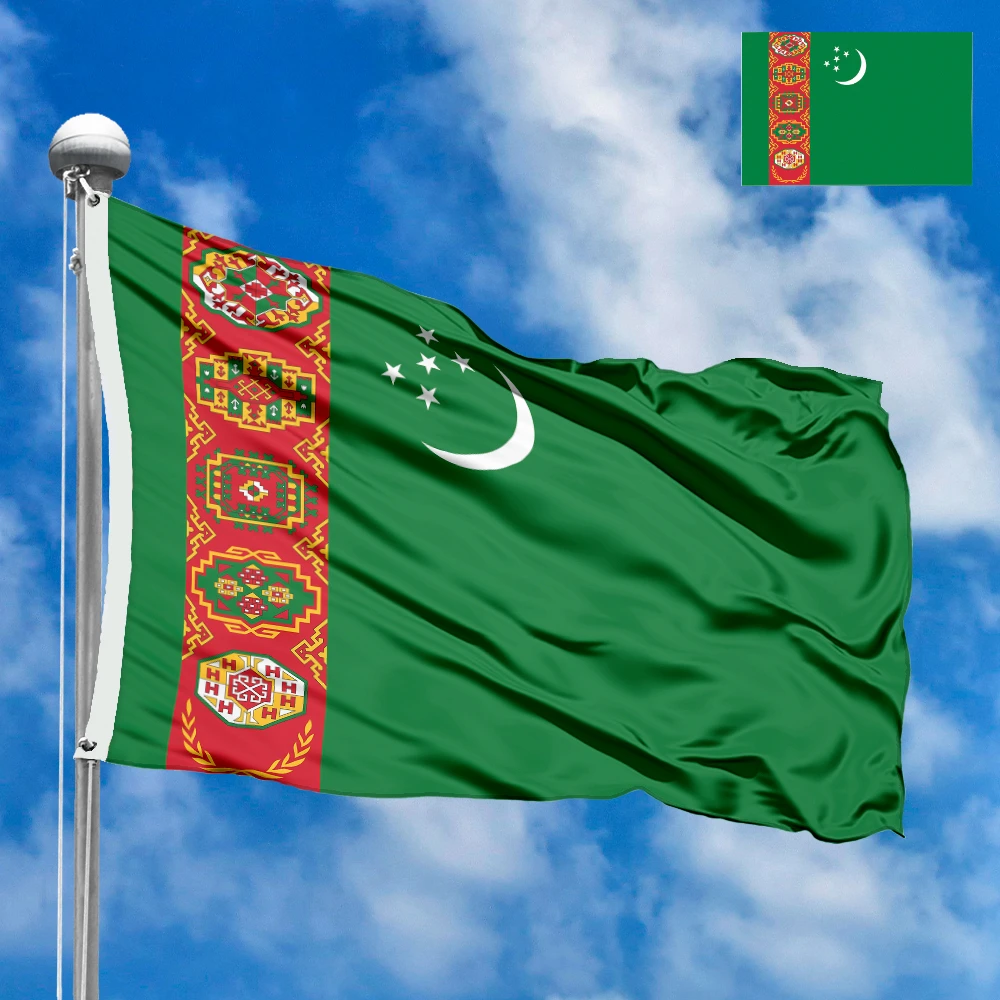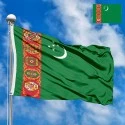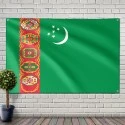The National Flag of Turkmenistan stands as a unique and intricate emblem, weaving together the nation's rich nomadic traditions, its profound historical narrative, and its aspirations for a prosperous future. Known for its distinct and highly detailed design, it's considered one of the world's most elaborate national flags. This powerful symbol serves as a constant reminder of Turkmenistan's independence, its deep cultural roots, and its commitment to national unity.
Description, Dimensions, and Element Arrangement
The Flag of Turkmenistan features a vibrant green background with a vertical red stripe positioned towards the hoist side. This red stripe contains five intricately designed carpet guls (patterns), stacked one above the other, each representing one of Turkmenistan's five major tribes: Akhal-Teke, Yomut, Saryk, Teke, and Chowdur. Below these guls, two crossed olive branches are depicted, symbolizing Turkmenistan's declared status of permanent neutrality, recognized by the United Nations. In the upper hoist corner of the green field, a white crescent moon and five white five-pointed stars are meticulously arranged.
The green color of the flag is deeply symbolic, representing the country's fertile lands, nature, life, and the predominant Islamic faith of the Turkmen people. The red stripe with its guls signifies the rich history of Turkmen carpet weaving, a central element of their cultural heritage and national identity. Each carpet gul tells a story, embodying the unique traditions and history of its respective tribe. The white crescent moon symbolizes the bright future and hopes of the nation, as well as the beginning of a new era. The five white stars represent the five major regions (velayats) of Turkmenistan, fostering a sense of unity across the country's geographical divisions. The official aspect ratio of the flag, defining its width to length, is 2:3, ensuring the intricate details are clearly visible and harmoniously balanced.
Creation and Evolution of the Flag
The creation of Turkmenistan's national flag is closely tied to the country's journey towards independence after the dissolution of the Soviet Union. Prior to its current design, Turkmenistan, as a Soviet Socialist Republic, used a flag that incorporated standard Soviet symbolism. Following its declaration of independence on October 27, 1991, there was an immediate need for new national symbols that would reflect Turkmenistan's unique cultural heritage and newly acquired sovereignty.
A special commission was tasked with developing a design that would encapsulate the nation's identity. The current flag was officially adopted on February 19, 1992, making it one of the first national symbols of the independent state. Its design underwent a minor revision on January 24, 2001, when the positions of the stars were slightly adjusted for aesthetic purposes, and the olive branches were added to specifically highlight Turkmenistan's neutrality. The intricate carpet guls were drawn from authentic Turkmen carpet designs, emphasizing the deep connection between the flag and the nation's artistic traditions. The decision to include specific tribal guls was a deliberate act to promote national unity and acknowledge the diverse yet cohesive nature of the Turkmen people.
Significance for the Nation
The Flag of Turkmenistan holds profound significance for the nation, embodying its sovereignty, independence, and the enduring strength of its cultural heritage. It serves as a powerful visual testament to the country's unique identity, a blend of ancient traditions and modern aspirations. For the government, the flag represents the guiding principles of the state, including its commitment to neutrality, peace, and internal unity.
For the Turkmen people, the flag is a source of immense national pride and a unifying symbol. It fosters a deep sense of belonging and connection to their ancestors, particularly through the intricate carpet guls which represent their tribal heritage and world-renowned weaving artistry. Displayed prominently during national holidays like Independence Day (September 27), Neutrality Day (December 12), and various cultural festivals, the flag inspires patriotism and a shared sense of purpose. It symbolizes their resilience, their rich history rooted in the Silk Road, and their collective journey towards a prosperous future, making it an deeply cherished emblem for every citizen.
Interesting Facts about the Flag of Turkmenistan
-
Most Detailed Flag: It's often cited as one of the most detailed national flags in the world due to the intricate carpet guls.
-
Neutrality Symbol: The olive branches beneath the guls explicitly symbolize Turkmenistan's official and recognized policy of permanent neutrality.
-
Tribal Representation: Each of the five carpet guls represents one of the five major Turkmen tribes, emphasizing the importance of tribal identity within the national fabric.
-
Carpet Weaving Heritage: The inclusion of carpet guls highlights Turkmenistan's world-renowned carpet weaving tradition, which is central to its cultural identity.
-
Five Regions, Five Stars: The five stars symbolize the five velayats (regions) of Turkmenistan, promoting geographical and administrative unity.
-
Green for Prosperity: The dominant green color represents the country's fertile lands, its natural resources, and the prosperity it seeks.
-
Post-Soviet Design: The flag was adopted shortly after the dissolution of the Soviet Union, marking a clear break from its communist past.
-
Minor Revision: While adopted in 1992, the flag underwent a minor design modification in 2001 to refine the star placement and add the neutrality symbol.
-
Official Flag Day: Turkmenistan celebrates National Flag Day on February 19th, commemorating its adoption.
Adoption and Reception
The formal adoption of the current Flag of Turkmenistan took place on February 19, 1992, by a special law, a pivotal moment in solidifying the visual identity of the newly independent nation. This followed the country's declaration of independence from the Soviet Union in October 1991. The design was the result of a national competition, reflecting the desire to create a symbol that authentically represented Turkmenistan's unique heritage.
The initial reception among the Turkmen population was overwhelmingly positive. The flag's design, rich with traditional Turkmen carpet patterns and other national symbols, was immediately embraced as a true representation of their cultural identity and newfound sovereignty. The inclusion of the carpet guls, a source of immense pride, resonated deeply with the people. A minor refinement to the flag, specifically the addition of the olive branches to symbolize neutrality, was made on January 24, 2001. This amendment further solidified the flag's meaning in the international arena. The flag's adoption was not merely a formality but a powerful statement of national self-determination, cementing its place as a revered emblem in the hearts of the Turkmen people.
Meaning for Residents
For the residents of Turkmenistan, the national flag is a source of immense pride, identity, and profound connection to their heritage. The dominant green color evokes the fertile lands and the hope for a prosperous future. The intricate carpet guls are particularly meaningful, as they represent the unique identity of their ancestral tribes and their world-renowned carpet weaving artistry, which is passed down through generations. These patterns tell stories of their history and their place within the broader Turkmen nation.
The crescent moon and five stars symbolize the bright prospects of their independent nation and the unity of its regions, while the olive branches proudly declare Turkmenistan's commitment to peace and neutrality on the global stage. Seeing their flag displayed, whether during national celebrations, at public institutions, or in daily life, evokes a deep sense of patriotism and collective belonging. It’s a constant visual reminder of their distinct cultural heritage, their hard-won independence, and their shared aspirations for a peaceful and thriving nation. The flag serves as a powerful unifying symbol, embodying the very soul of the Turkmen people.
In the demonstration images, full-size flags are shown with proportions of 2:3, and hand-held flags with proportions of 1:2.






 Waving flag
Waving flag
 Sizes:
Sizes:
 Round flag
Round flag
 Sizes:
Sizes:
 Rectangular flag 2:3
Rectangular flag 2:3
 Sizes:
Sizes: